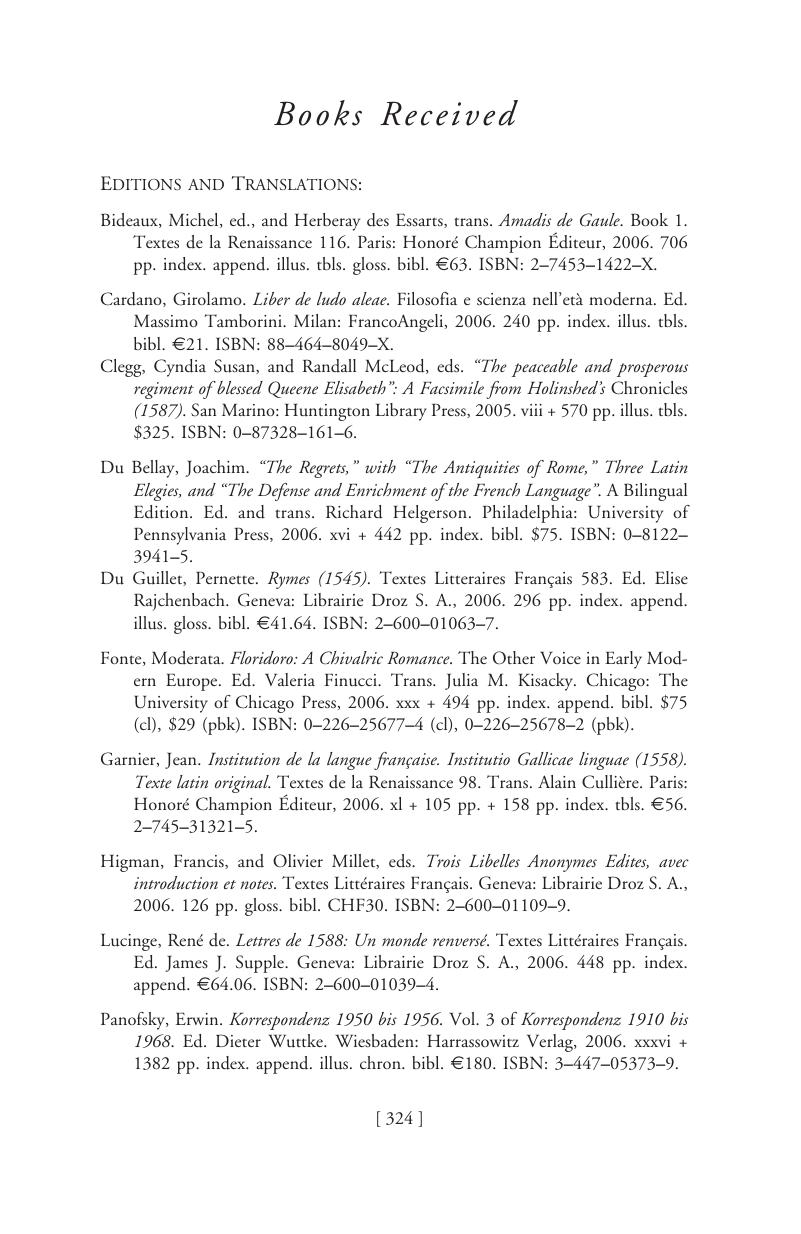Marie-Sol, Ortola, and,
Roig Miranda, Marie, eds.
Langues et identités culturelles dans l’Europe des XVIe et XVIIe siècles. Vol. 1. Actes du colloque international organisé à Nancy (13, 14 et 15 novembre 2003). Europe XVI–XVII 7.
Nancy: Groupe de recherche “XVI
e et XVII
e siècles en Europe”,
2005. 390 pp. tbls € 18. ISBN:
2-9515883-6-4.
Includes: Marie-Luce Demonet, “Les climats linguistiques”; Nathalie Fournier, “Outillage et bricolage dans la grammaire française aux XVI
e et XVII
e siècles: l’exemple de la
Grammaire et syntaxe françoise de Charles Maupas (1618)”; Gilbert Fabre, “La langue des Morisques de Castille et d’Aragon ou l’espace discursif de la trace en Espagne aux XVI
e et XVII
e siècles”; Anne-Élisabeth Spica, “Identité sociale et code linguistique: le discours emblématique et ses commentaires dans le
Mercure galant (1672–1692)”; Édith Mazeaud-Karagiannis, “Langues et identités culturelles dans la Grèce du XVI
e siècle: le temoignage de Belon, Thevet, Nicolay”; José Manuel Losada, “Langues européennes d’une période mouvementée”; Corinne Mencé-Caster, “Diachronie des formes d’expression de la courtoisie et configurations des idenitités socioculturelles en Espagne: XIII
e–XVII
e siècles”; Concetta Cavallini, “La correspondence officielle entre les chancelleries italiennes et la cour de France en 1570–1590. La contribution de la langue à la formation d’un stéréotype antiitalien”; Alexandra Testino-Zafiropoulos; “Rodomontades espagnoles et identité nationale: des
belles paroles proférées à l’improviste”; Cécile Bertin-Elisabeth, “Poétique de la fermeture dans le roman picaresque: un langage identitaire?”; Alain Cullière, “Grammaire et prédication. Du bon usage de l’
Institutio Gallicae linguae de Jean Garnier (1558)”; Marie-Hélène Maux-Piovano; “L’indentité (culturelle?) espagnol au XVII
e siècle d’apres le recueil phrasèologique d’A. de Salazar (1614)”; Claude Brévot Dromzée, “Le prospectus d’un académicien.
Discours d’un fidele sujet du Roy, touchant l’establissement d’une Compagnie Françoise pour le Commerce des Indes Orientales (1664)”; Florence Alazard, “à la recherche d’une langue politique: les
lamenti du XVI
e siècle”; Jean-Gérard Lapacherie, “Le mythe de l’ordonnance de Villers-Cotterets”; Marc Zuili, “Défense de la langue vernaculaire et naissance d’un sentiment national dans l’Espagne des XVI
e et XVII
e siècles”; Jean-François Courouau, “Une langue pour un royaume? La dénomination du catalan à Valence aux XVI
e et XVII
e siècles”; Karine Durin, “La langue: ‘un bien común a todos’. Approche de l’idée de langue commune en Espagne au Siècle d’Or”; Hugues Didier, “L’Espagne écartelée entre une identité à fondement linguistique (le castillan ou espagnol) et l’idéal d’une monarchie chrétienne universelle”; Jean Lacroix, “L’enjeu linguistique et patriotique de la
Jérusalem délivrée”; Martial Martin, “Le plurilinguisme et la question de l’identité culturelle française dans la
Satyre Menippee de la vertu du catholicon d’Espagne et de la tenue des Estatz de Paris”; Véronique Luzel, “Le nationalisme linguistique dans le
Palais des curieux (1612) de Béroalde de Verville”; Antonella Amatuzzi, “Les États de Savoie aux XVI
e et XVII
e siècles: deux langues et deux identitès culturelles?”; and Jean Schillinger, “Le combat contre l’hégémonie linguistique française chez les pamphlétaires allemands de la seconde moitié du XVII
e siècle.”
Google Scholar 